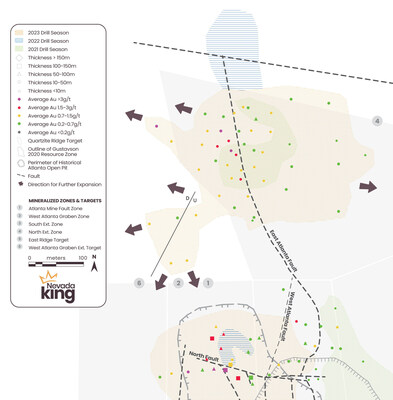NEVADA KING INTERSECTS HIGH-GRADE OXIDE GOLD 600M NORTH OF THE ATLANTA PIT WITH 9.72 G/T AU OVER 9.1M WITHIN 47.3M OF 2.57 G/T AU, DOUBLES SIZE OF THE "NORTH EXTENSION TARGET"
- Significant gold mineralization reported from 25 vertical, reverse circulation holes
- Drilling more than doubles the footprint of the North Extension Target
- High-grade gold zones identified, prompting further exploration
- Potential for connecting mineralized zones and evolving geological model revealed
- Scientific and technical information reviewed and approved by a Qualified Person
- None.
Highlights:
Hole No. | From (m) | To (m) | Interval (m) | Au (g/t) | Ag (g/t) |
AT23NS-144 | 100.6 | 125.0 | 24.4 | 1.98 | 0.4 |
AT23NS-155 | 146.3 | 193.6 | 47.3 | 2.57 | 4.4 |
Includes | 160.1 | 169.2 | 9.1 | 9.72 | 15.5 |
Table 1: Highlight holes released today. Mineralization occurs along near-horizontal horizons with true |
- Highlight interval of 9.72 g/t Au over 9.1m within 2.57 g/t Au over 47.3m is the best interval recorded to date within the North Extension Target ("NET"), a shallow, strongly oxidized gold zone located approximately 600m north of the
Atlanta pit that is not included within the 2020 National Instrument 43-101 ("NI 43-101") resource. - The NET formed along the northern extension of the Atlanta Mine Fault Zone ("AMFZ") was originally identified by historical drilling, but intercepted grades and thicknesses were too low to maintain interest in the target. It was
Nevada King's high-grade intercept of 8.26 g/t Au over 9.1m within 4.64 g/t Au over 18.3m in AT21-3 (November 22, 2021) that opened up the NET's potential, while later intercepts of 1.67 g/t Au over 24.4m in AT22NS-13 (November 23, 2022) and 1.83 g/t Au over 21.3m in AT22NS-15 (December 20, 2022) further expanded the higher-grade "core" mineralization localized along the AMFZ. - Today's drilling more than doubles the footprint of NET from the previously reported 175m N-S x 300m E-W (December 20, 2022) to an area that now spans 330m N-S by 350m E-W (see Figure 1 below).
- The 25 holes released today are plotted on eight separate cross sections together with 25 previously released
Nevada King holes and 18 historical holes (Figures 3-10). Mineralization occurs along a gently west-dipping horizon developed at the contact between basal Ordovician age dolomite and overlying Tertiary age volcanics. This silicified contact is vertically displaced 60m to 80m across the northerly-trending AMFZ with the west side down, similar to what is seen all along the AMFZ. - The highest grade intervals are found proximal to the AMFZ along a 50m-wide corridor centred on the fault zone, as demonstrated by previously released hole AT23NS-112 grading 4.08 g/t Au over 21.3m. Gold grades tend to gradually decrease westward and eastward from the AMFZ, although high-grade does occur outside of this corridor, including previously released hole AT23NS-109 grading 3.69 g/t Au over 13.7m, located 100m west of the AMFZ.
- The distribution of both grade and thickness for
Nevada King's reported holes is shown in Figure 1 where the thicker, higher-grade mineralization is concentrated along the AMFZ and also along a WNW-trending fracture zone that intersects the AMFZ, where the highest grades are found. The gradual decrease in grade and thickness moving eastward from the AMFZ is evident, but to the west both thickness and grade remain fairly uniform from hole to hole over a large area, albeit at greater depth. - The vector arrows in Figure 1 show the directions in which mineralization remains open around the NET. The east-directed vector is heading toward the still-to-be tested East Ridge Target, while the other vectors indicate potential to the west and south. A 100m gap currently exists between the NET and the northern edge of the main resource zone, so the southerly-directed vectors indicate good potential for connecting these two mineralized zones together. The Company is currently drilling this gap and also expanding the drill pattern westward.
Cal Herron, Exploration Manager of
Hole No. | From (m) | To (m) | Interval (m) | Au (g/t) | Ag (g/t) |
AT23NS-134* | 94.5 | 128.0 | 33.5 | 0.19 | <0.5 |
AT23NS-135 | 99.1 | 125.0 | 25.9 | 0.20 | <0.5 |
AT23NS-136 | 79.3 | 99.1 | 19.8 | 0.46 | 0.5 |
AT23NS-137 | 44.2 | 53.4 | 9.1 | 0.21 | 4.0 |
And | 82.3 | 89.9 | 7.6 | 0.24 | <0.5 |
AT23NS-138 | 96.0 | 106.7 | 13.7 | 0.36 | 1.8 |
AT23NS-139 | 27.4 | 33.5 | 6.1 | 0.22 | 3.7 |
AT23NS-140 | 79.3 | 105.2 | 25.9 | 0.35 | 1.8 |
AT23NS-141 | 73.2 | 74.7 | 1.5 | 0.31 | 3.4 |
AT23NS-142 | 122.0 | 155.5 | 33.5 | 0.40 | 0.7 |
AT23NS-143 | 97.6 | 146.3 | 48.8 | 0.73 | <0.5 |
AT23NS-144 | 100.6 | 125.0 | 24.4 | 1.98 | <0.5 |
AT23NS-145* | 109.8 | 131.1 | 21.3 | 0.42 | 1.9 |
AT23NS-147 | 144.8 | 161.6 | 16.8 | 0.74 | 3.5 |
AT23NS-148 | 93.0 | 147.9 | 54.9 | 0.65 | <0.5 |
AT23NS-150* | 230.2 | 253.0 | 22.9 | 1.02 | 7.1 |
AT23NS-151 | 231.7 | 257.6 | 25.9 | 0.97 | 23.1 |
AT23NS-152 | 140.2 | 158.5 | 18.3 | 0.74 | 18.4 |
AT23NS-153 | 195.1 | 227.1 | 32.0 | 0.73 | 5.3 |
AT23NS-154 | 184.5 | 213.4 | 29.0 | 1.34 | 7.2 |
AT23NS-155 | 146.3 | 193.6 | 47.3 | 2.57 | 4.4 |
Includes | 160.1 | 169.2 | 9.1 | 9.72 | 15.5 |
AT23NS-156 | 103.7 | 135.7 | 32.0 | 0.48 | 1.0 |
AT23NS-157 | 251.5 | 283.5 | 32.0 | 0.77 | 16.4 |
AT23NS-158* | 216.5 | 245.4 | 29.0 | 0.91 | 1.9 |
AT23NS-159 | 166.2 | 186.0 | 19.8 | 1.15 | 14.0 |
AT23NS-160* | 91.5 | 129.6 | 38.1 | 0.40 | 2.7 |
Table 2. Holes released today. Mineralization occurs along near-horizontal horizons with true mineralized thickness in |
Hole No. | From (m) | To (m) | Interval (m) | Au (g/t) | Ag (g/t) |
AT23NS-108 | 182.9 | 210.4 | 27.4 | 0.31 | 4.0 |
AT23NS-109 | 225.6 | 239.3 | 13.8 | 3.69 | 1.3 |
AT23NS-110* | 175.3 | 201.2 | 25.9 | 1.21 | 3.5 |
AT23NS-111 | 175.3 | 190.5 | 15.2 | 0.49 | 1.2 |
AT23NS-112 | 155.5 | 176.8 | 21.3 | 4.03 | 6.7 |
AT23NS-113 | 256.1 | 297.3 | 41.2 | 0.40 | 5.4 |
AT23NS-114 | 190.5 | 227.1 | 36.6 | 0.77 | 5.8 |
AT23NS-115 | 218.0 | 231.7 | 13.7 | 0.82 | 7.1 |
AT23NS-127 | 117.4 | 146.3 | 28.9 | 0.96 | 1.5 |
AT23NS-10A | 105.2 | 144.8 | 39.6 | 0.68 | 2.0 |
AT21-002C+ | 86.3 | 104.6 | 18.3 | 0.56 | 2.1 |
AT22NS-009 | 86.9 | 128.0 | 41.2 | 0.65 | <0.5 |
AT22NS-011* | 102.1 | 125.0 | 22.9 | 1.36 | 0.5 |
AT22NS-013 | 135.7 | 160.1 | 24.4 | 1.67 | <0.5 |
AT22NS-012 | 175.3 | 195.1 | 19.8 | 1.77 | <0.5 |
AT22NS-014 | 99.1 | 143.3 | 44.2 | 0.71 | <0.5 |
AT22NS-016 | 91.5 | 106.7 | 15.2 | 0.54 | <0.5 |
AT22NS-017 | 85.4 | 114.3 | 28.9 | 0.46 | 2.7 |
AT22NS-018 | 178.4 | 193.6 | 15.2 | 0.70 | 4.5 |
AT22NS-019 | 166.2 | 179.9 | 16.8 | 0.31 | 2.5 |
AT21-001* | 94.5 | 131.1 | 25.9 | 1.00 | <0.5 |
AT21-002 | 82.3 | 105.2 | 22.9 | 0.71 | <0.5 |
AT21-003 | 155.5 | 173.8 | 18.3 | 4.64 | 11.2 |
AT21-004 | 85.4 | 118.9 | 33.5 | 0.74 | 1.4 |
AT21-005 | 99.1 | 103.7 | 4.6 | 0.42 | 3.4 |
DHRI-11-04RC | 103.7 | 123.5 | 19.8 | 0.47 | <0.5 |
DHRI-11-05RC | 61.0 | 82.3 | 21.3 | 0.24 | 3.0 |
DHRI-11-06RC | 76.2 | 77.7 | 1.5 | 0.10 | 7 |
DHRI-11-07RC* | 74.7 | 108.2 | 33.5 | 0.18 | 0.7 |
DHRI-11-08RC | 120.4 | 143.3 | 22.9 | 0.30 | 3.84 |
DHRI-11-08C^ | 175.3 | 182.9 | 7.6 | 0.09 | <0.5 |
DHRI-11-12C^ | 297.3 | 304.9 | 7.6 | 0.27 | 11.4 |
DHRI-11-13C | 169.2 | 213.4 | 44.2 | 0.27 | 1.7 |
DHRI-11-14C^ | 129.6 | 158.5 | 28.9 | 0.05 | 1.1 |
KN98-02+ | 42.7 | 57.9 | 15.2 | 0.14 | 9.5 |
KN98-10+ | 198.2 | 211.9 | 13.7 | 1.19 | 1.0 |
KN98-11+ | 230.2 | 253.0 | 22.9 | 2.07 | 0.7 |
KN98-12 | 196.6 | 224.1 | 27.5 | 0.77 | 1.9 |
KN98-13+ | 231.7 | 274.4 | 42.7 | 0.67 | 0.3 |
KN98-14+ | 237.8 | 265.2 | 27.4 | 0.48 | 3.0 |
AR-06+ | 146.3 | 157.0 | 10.7 | 0.14 | 29.8 |
AR-07+ | 112.8 | 137.2 | 24.4 | 0.73 | 0.6 |
90-04 | 208.8 | 256.1 | 47.3 | 0.11 | 2.9 |
Table 3. Previously released drill holes and historic drill holes used in today's cross sections. AT series holes were drilled by |
All RC samples from the Atlanta Project are split at the drill site and placed in cloth and plastic bags utilizing a nominal 2kg sample weight. CRF standards, blanks, and duplicates are inserted into the sample stream on-site on a one-in-twenty sample basis, meaning all three inserts are included in each 20-sample group. Samples are shipped by a local contractor in large sample shipping crates directly to American Assay Lab in
The scientific and technical information in this news release has been reviewed and approved by Calvin R. Herron, P.Geo., who is a Qualified Person as defined by NI 43-101.
The Atlanta Mine is a historical gold-silver producer with a NI 43-101 compliant pit-constrained resource of 460,000 oz Au in the measured and indicated category (11.0M tonnes at 1.3 g/t) plus an inferred resource of 142,000 oz Au (5.3M tonnes at 0.83 g/t). See the NI 43-101 Technical Report on Resources titled "Atlanta Property,
Resource Category | Tonnes (000s) | Au Grade (ppm) | Contained Au | Ag Grade (ppm) | Contained Ag |
Measured | 4,130 | 1.51 | 200,000 | 14.0 | 1,860,000 |
Indicated | 6,910 | 1.17 | 260,000 | 10.6 | 2,360,000 |
Measured + Indicated | 11,000 | 1.30 | 460,000 | 11.9 | 4,220,000 |
Inferred | 5,310 | 0.83 | 142,000 | 7.3 | 1,240,000 |
Table 4. NI 43-101 Mineral Resources at the Atlanta Mine |
Please see the Company's website at www.nevadaking.ca.
Neither the TSX Venture Exchange nor its Regulation Services Provider (as that term is defined in the policies of the TSX Venture Exchange) accepts responsibility for the adequacy or accuracy of this release.
This news release contains certain "forward-looking information" and "forward-looking statements" (collectively "forward-looking statements") within the meaning of applicable securities legislation. All statements, other than statements of historical fact, included herein, without limitation, statements relating the future operations and activities of
![]() View original content to download multimedia:https://www.prnewswire.com/news-releases/nevada-king-intersects-high-grade-oxide-gold-600m-north-of-the-atlanta-pit-with-9-72-gt-au-over-9-1m-within-47-3m-of-2-57-gt-au-doubles-size-of-the-north-extension-target-302036934.html
View original content to download multimedia:https://www.prnewswire.com/news-releases/nevada-king-intersects-high-grade-oxide-gold-600m-north-of-the-atlanta-pit-with-9-72-gt-au-over-9-1m-within-47-3m-of-2-57-gt-au-doubles-size-of-the-north-extension-target-302036934.html
SOURCE Nevada King Gold Corp.


















